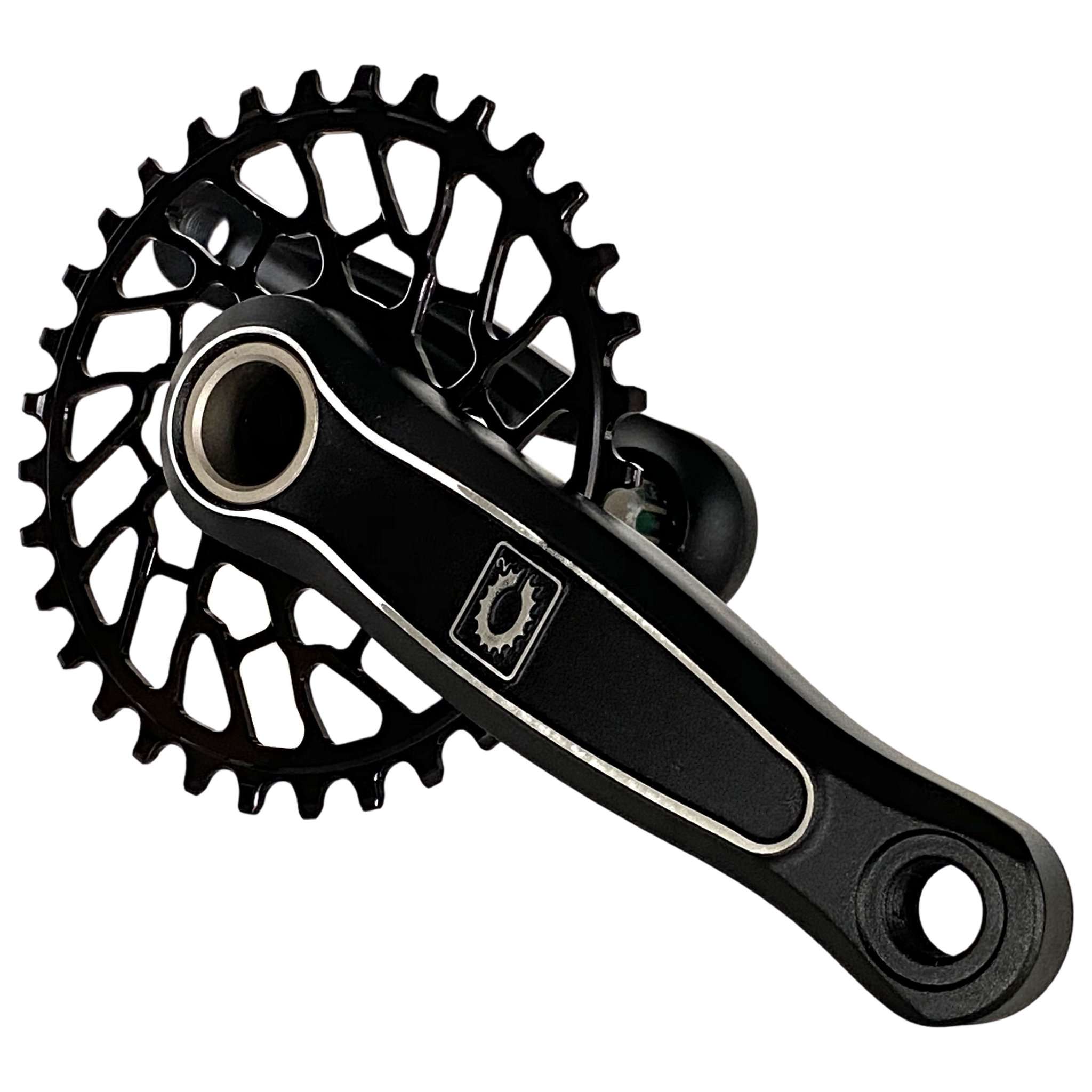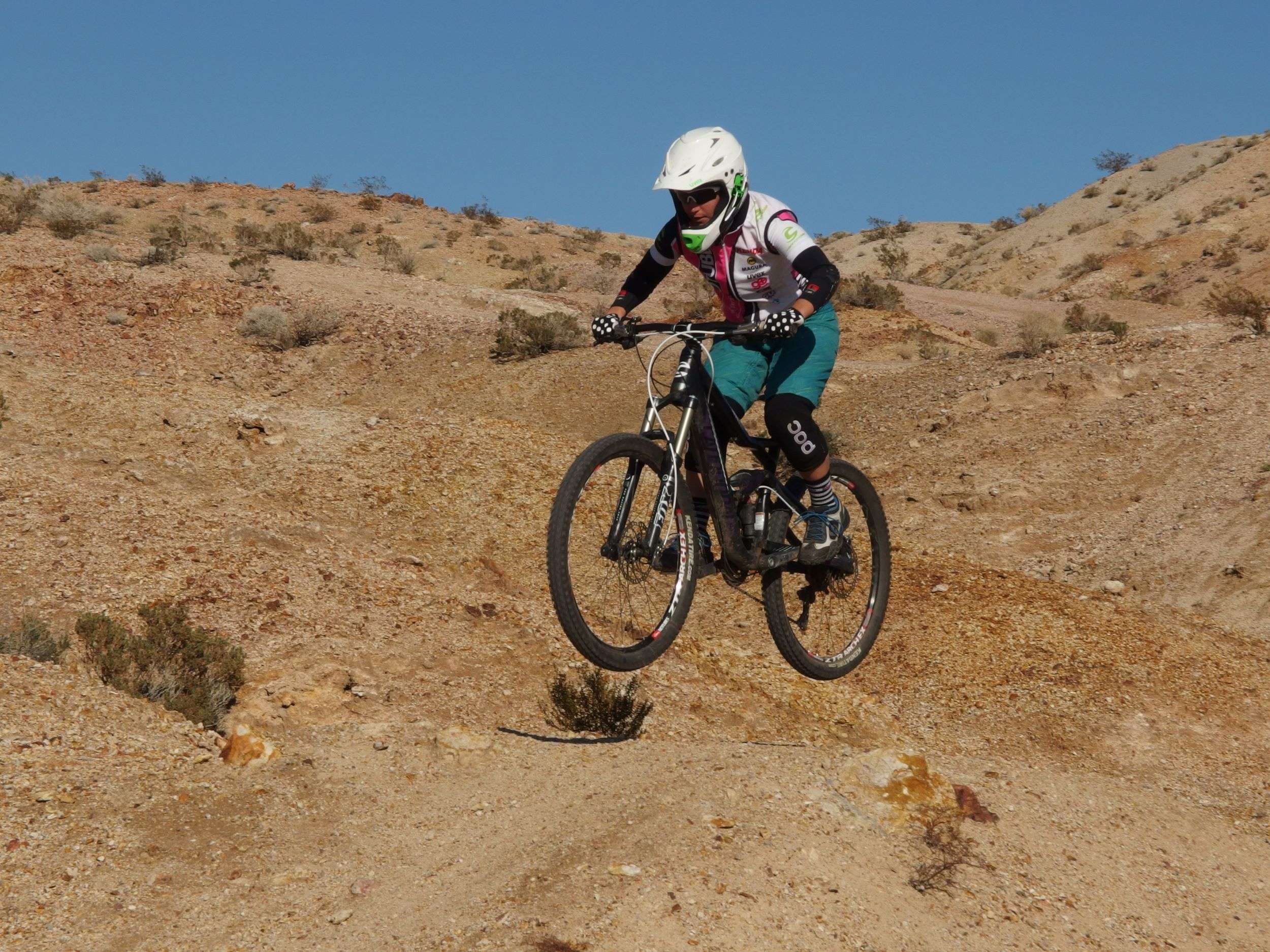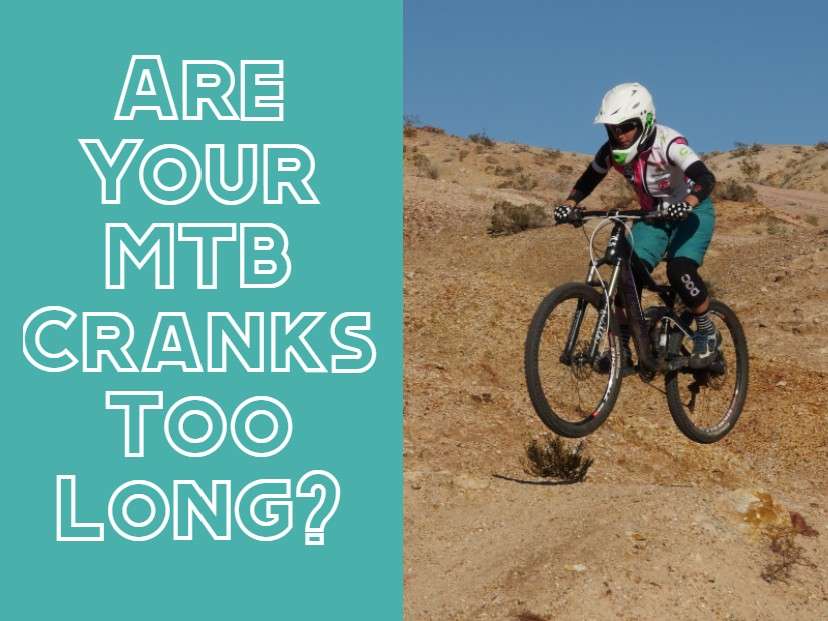Changing the length of your MTB cranks could increase your enjoyment of the sport and increase your longevity in the sport.
There are so many things in mountain biking that are done “because that’s what we have always done”. Until recently many “experts” were wrong about so many things that affect our riding.
Experts said higher tire pressure rolls faster, as do skinnier tires, we should cut our handlebar width to the width of our shoulders, you can’t climb well with a short stem and/or slack head angle, etc. and they were all wrong!
As someone who likes to understand the science of why things work, this attitude of “that’s how we have always done it” in mountain biking has always annoyed me. I do my best to question everything, especially when I feel I can improve my riding by changing something.
What I have never seen is a truly scientific study of various crank lengths. Lennard Zinn published a test about 20 years ago in Velo News. He had around 10 cyclists of all different heights do three tests (a time trial, hill climb, and power output test) using cranks from 145-185mm, and as I recall the results were all over the board.
Some of the tallest riders did best with shorter cranks and one of the shortest riders performed best with 185mm cranks. My wild guess was, it depended on a thigh to shin ratio or perhaps how much slow-twitch muscle vs fast-twitch muscle the rider had.
Two of my friends, Lance and Chris Canfield (founders of Canfield Bikes) both love 155mm cranks even though they are both over six feet tall. They claim the smaller circle pedaled is easier to pedal than the circle created by longer cranks. This is due to less knee flection, for example, we can squat greater weight from a half squat than a full squat.

Canfield AM/DH cranks
In other words, a shorter crank does give you less leverage, but that shorter crank arm allows your downstroke to start where your body can create more power. This (according to the Canfields) produces more power and (according to the study cited below) is better for your knees and hips.
One of my students and pro cross country racer Sarah Kaufman who is 4’11”, also likes 155mm cranks (possibly 145mm, I spoke with her about this nearly a decade ago). I believe her cranks were Sram kids’ cranks.

All Four feet eleven inches of Sarah Kaufman catching air for the first time in a private lesson years ago at Bootleg Canyon.
Well, I finally found some information that makes sense of crank length. It isn’t a truly scientific study taking all variables into account, but using knee pain, hip hinge, and knee flection at the top of the pedal stroke as a gauge, these bike fitters came to some interesting conclusions.
Their article can be found here: At All Levels and Categories of Cycling: Correct Poor Crank-arm Fit to Relieve Chronic Knee (and Hip) Pain
A quick summary (though I do suggest you read their article) is that inseam length and crank length are correlated. Someone with an inseam of 28” (71cm) should run 150mm cranks while someone like me with a 90cm (35.5 inch) inseam, should run cranks no longer than 173mm.
The article has the recommend crank size for inseams from 70 to 93cm. Give it a read and you may end up thanking them for saving your knees!
This means for decades bike manufactures may have had it all wrong. Until our bottom brackets got so low that pedal strikes became common most size large bikes came with 175mm cranks while size small bikes came with 170mm crank arms. As a matter of fact, it is hard to find MTB cranks that are shorter than 165mm (and those 165’s are usually heavy-duty cranks made for downhill bikes).
As far as I know, the only 155mm MTB cranks on the market are made by Canfield Bikes. I honestly haven’t tested cranks shorter than 165, but I certainly didn’t notice any negatives with the 165s. A definite positive with the 165mm cranks were fewer pedal strikes!
How long are your legs?
What crank length are you running?
Have you spent two weeks testing shorter crank lengths?
If you are suffering from knee pain, hip pain, or overly tight hips you might want to try some shorter cranks. Let us know!
Please share this article with anyone you think may benefit and feel free to call or e-mail with any questions.
Thanks and create your best ride yet,
Gene





Gene, I’ve always wondered the same thing about getting the right crank length. Fantastic content, as always. Thank you. It would appear that buying a new bike will pose a challenge if the industry standard is too long. Getting the geometry (chain line and sprocket size & correlating angles with cassette sprockets, with compatible derailleur etc.) of the drive-train correct on my custom build was a little aggravating back in 1997, and I don’t expect it to be any easier to find a crank to substitute for this application, or on a new bike. Oh, the rabbit trails that enlightenment takes us down! I do hope you influence the industry and that they will spec out the bikes accordingly one day.
Hi Randy,
Thanks! I hear you, I switched cranks a few years ago and it created all kinds of shifting problems due to the change in chain line. Unfortunately, I don’t think I influence the industry too much, but they have adapted longer reach measurements, shorter stems, and slacker head angles but it was years after I started preaching those ideas!
I’m 6’4″ with a 38″ inseam. I tried 180’s from 175’s and didn’t like them at all. I was surprised how many more rock strikes and how I much I noticed turning the bigger circle with such a small difference in crank length compered to my leg length. I have 170’s on my road/gravel bike and like them fine and wouldn’t hesitate to try them on my MTB. It can be an expensive experiment to try to figure out what works best for you.
Wow, Jeff, those are some long legs! Good to hear from another tall person. I’m going to experiment with 155mm cranks and see what I think, fortunately, Canfield bikes saw my article and letting me demo a pair.
This is a good article by Rick. Many mountain bikes come with cranks too long for effective use by the rider, especially the XS and S sizes.
Mountain bike designers and product managers don’t devote enough consideration to component selection from a bike fit and biomechanical perspective, especially for riders that fall outside the middle of the bell curve for size and proportions.
Cobb and Rotor are two brands that also make shorter cranks.
Funny, I was going to email you and ask what you thought of this! Thanks for sharing John! And thanks for the tips on Rotor and Cobb cranks!
Very interesting articles! I have experienced mild knee pain for as long as I have been riding MTB, which is only about 8 years. I’m 66 now and have an inseam of about 30-31″. Just went and measured my cranks and they are 177mm which is about 20mm longer than the base recommendation! So I am curious to try the recommended length. One question I have though is that in the article by Schultz & Schultz, they are dealing with road riders. Should it be exactly the same for MTB, or are there differences. Road riders do have to do some climbing, but nothing like we do on MTB. There is one particular climb on the trail I usually ride that I just cleared for the first time last week, so am curious to see if shorter cranks would make it harder to clear it.
Hi David,
I’m glad to hear you find my articles interesting. Before I answer your question let me explain how to measure your crank arm length. First, crank length is usually stamped on the inside of each crank arm (on aluminum cranks) so that is the easiest way! To measure crankarm length you measure from the center of the bottom bracket shaft to the center of the pedal spindle. I mention this as most mountain bikes come with either 170mm or 175mm cranks.
I don’t have experience with cranks shorter than 165mm but I am going to try some 155mm cranks so stay tuned for my review of those. However, my inseam is quite a bit longer than yours and I find I climb fine with 165mm cranks and the smaller circle my legs are spinning is noticeable. So I feel you will climb as well or better than with your current cranks. If shorter cranks eliminate your knee pain I think that would be a bigger benefit than climbing ability though! Give shorter cranks a try! The worst that happens is you don’t like them but the best that happens is your knee pain goes away and you climb and ride better!
Create your best ride yet,
Gene
Great stuff in that article and I’ve passed it on to a bunch of fellow riders. Appears I should be on 165’s and my bike has 175’s. Actually both bikes, road and mountain.
2 questions
Do elliptical chain rings have any impact on crank arm length?
Should I be measuring my inseam with the shoes on that I’ll be riding in? In my head this makes sense but I don’t know?
Thanks
Hi Jeff,
I love oval chainrings, don’t feel crank length matters when using one but I have never any research on the subject. I believe that chart is based on your actual inseam, I have never heard of measuring it with shoes on. Measuring with riding shows on makes sense when setting saddle height but for crank length they just want to know how long your legs are.
Let us know what you think of your 165’s after a few weeks of riding them.
Cheers,
Gene
Curious how the 155 crankarms are coming along? I just switched my Specialized Enduro 29 Six Fatty or whatever they called it to 27.5 2.5’s to up my enduro game and now getting pedal strikes with the 175’s. I think I’m going to give 165’s a try.
Hi Kenny,
I’m waiting on a new cassette, should have the cranks on early next week!
So after a year someone resurrected this thread, so I thought I’d report back as well. I don’t notice any difference with the 165 cranks unless I jump directly off of 175’s and onto the 165’s, and even then just barely I adjust after just a few strokes of the pedal and never give it another thought. For long travel bikes especially, its a no brainer, shorter is worth any negative it may have.
Hi Kenny, thanks for the update. That is good to hear. I’m still waiting on a bb and correct offset chainring so I can test the 155s and 165s.
Cheers,
Gene
Interesting article Gene. It made me feel less weird for running 155mm cranks for the last year (i’m 6 ft tall). I run 155, 165 and 170mm on my three bikes. I honestly do not really notice difference and went to 155 on my main bike for less pedal strikes. I have never been able to use 175mm cranks and feel comfortable ever in the last 35 years of riding.
Another 6 footer with short cranks, until I wrote this article I didn’t realize how many people were already running shorter cranks (and probably feeling weird about it). Thanks, Simon
I’m 6 foot tall and weigh 200 lbs (and 42 years old if that matters at all) and i’m on 115mm cranks, the crank sizes discussed elsewhere in this thread are marginally! lol
And i can do everything any other mountainbiker can do (both power and handling wise).
Pedal strikes … had 2 strikes in the past 3 years! lol I can pedal where no other can pedal… most corners and turns over rocks and cutoff trees.
The one thing i figured out when you change crank size is that you need to adjust not only the seat height but also not to forget the gearing. My seat went up with about 60mm and i went from a 32t to a 26t chainring (cant find anything smaller). You need to adjust both when you change the crank size, even if its just 1mm.
Although the reason is medical to go this short i wouldn’t go back to regular sized cranks if my busted knee would magically be “fixed” one day…
Ps.
I’ve reached out to canfield hoping for their support to get even shorter cranks than they currently offer right now, unfortunately they never responded… Perhaps your efforts to motivate people to go to shorter cranks will inspire them to offer an even broader spectrum in crank sizes.
Thanks for your input, I haven’t even thought about even shorter cranks! Interesting!
Gene, where do I find the 155mm crank arm review that you talked about? I am really interested in reading it as I am194cm tall with a 93cm inseam, and my current cranks are 175mm. Thanks.
Hi Quentin,
If you are referring to my test, I haven’t done it yet (wrong bb!)
After reading the original article, I decided to give shorter cranks a try. I had bought my first bike used from a guy who was a lot taller than me and it had 175s on it. So I ordered the Canfield 160s. According to the chart, I should have gone even shorter, but was afraid to make that big of a change. I’m on a tight budget and can’t afford to buy another set of cranks. I also switched to an oval chain ring at the same time. When I first got on the bike it felt really weird! The cranks felt VERY short. But after a few rides I got used to them and they are fine. I can’t really say it has made a big difference, but I think my knees have felt slightly better after a long ride. I just had my first ride yesterday after not having been able to ride for various reasons (not health) for two months. I took it easy and only rode about 12 miles, but had no issues with knees at all.
Hi David, sorry to hear about the health issues but glad to hear that you are past them and riding again. Thanks for the update!
Cheers,
Gene
Thanks, Gene, but as stated in my comment, my reasons for not being able to ride were NOT health related. 😉 We had a lot of rain in Texas and the trail I usually ride was flooded, plus I had a lot of travel for work culminating in a three week trip that I just got back from.
Whoops, miss read your comment! Wow, I had to cancel two Austin courses for freezing weather and no power then Texas floods! Crazy weather as we are suffering from a drought just to your West. Glad it wasn’t health related!
I went the other direction. I’m 6’5″ and have a 39″ inseam. I ordered a bike from Zinn. It was spec’d with 200 mm cranks base on my inseam. The frame has a BB height of 15″ as opposed to the typical 13″ BB height. Going from 175 mm cranks to the 200 mm made a huge difference. I no longer have hip and knee pain. I
Hi Jeff,
Interesting, thanks for posting. Zinn did a test 20 years or more ago in Velo with different height riders and different crank lengths. As I recall the results were all over the board.
Wow, a 15″ high bottom bracket, that really changes the handling characteristics of a bike.
Thanks for the interesting article!
One aspect of crank length that has not been covered is that using longer cranks allows to lower the saddle.
I have 97 cm inseam for 198 cm total height, which means that, for my height, I have very long legs and a short torso. As a consequence, I need to set the saddles on my bikes very high.
My Canyon Spectral 29 (frame size XL) came with 170 mm cranks. Exchanging these for 175 mm cranks (like on my road and commute bikes) allowed my to lower the saddle by 5 mm which was noticeable. The downside is reduced ground clearance when pedaling, but I can deal with this most of the time by syncing the pedal stroke with obstacles.